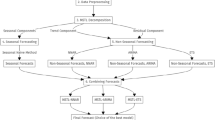Abstract
The complex signal represented by power load is affected by many factors, so the signal components are very complicated. So that, it is difficult to obtain satisfactory prediction accuracy by using a single model for the complex signal. In this case, wavelet decomposition is used to decompose the power load into a series of sub signals. The low frequency sub signal is remarkably periodic, and the high frequency sub signals can prove to be chaotic signals. Then the signals of different characteristics are predicted by different models. For the low frequency sub signal, the support vector machine (SVM) is adopted. In SVM model, air temperature and week attributes are included in model inputs. Especially the week attribute is represented by a 3-bit binary encoding, which represents Monday to Sunday. For the chaotic high frequency sub signals, the chaotic local prediction (CLP) model is adopted. In CLP model, the embedding dimension and time delay are key parameters, which determines the prediction accuracy. In order to find the optimal parameters, a segmentation validation algorithm is proposed in this paper. The algorithm segments the known power load according to the time sequence. Then, based on the segmentation data, the optimal parameters are chosen based on the prediction accuracy. Compared with a single model, the prediction accuracy of the proposed algorithm is improved obviously, which proves the effectiveness.












Similar content being viewed by others
References
Hu, D.G., Shu, H., Hu, H.D.: Spatiotemporal regression Kriging to predict precipitation using time-series MODIS data. Cluster Comput. 20(1), 347–357 (2017). SI
Zhang, G.W., Xu, L.Y., Xue, Y.L.: Model and forecast stock market behavior integrating investor sentiment analysis and transaction data. Cluster Comput. 20(1), 789–803 (2017)
Hirata, Y., Aihara, K.: Improving time series prediction of solar irradiance after sunrise: comparison among three methods for time series prediction. Solar Energy 149, 294–301 (2017)
Yang, G.L., Cao, S.Q., Wu, Y.: Recent advancements in signal processing and machine learning. Math. Probl. Eng. 2014 Article ID 549024 (2014)
Moreau, F., Gibert, D., Holschneider, M., et al.: Identification of sources of potential fields with the continuous wavelet transform: basic theory. J. Geophys. Res. 104(B3), 5003–5013 (1999)
Mallat, S.: A Wavelet Tour of Signal Processing: The Sparse Way, vol. 3. Elsevier, Amsterdam (2009)
Kumari, G.S., Kumar, S.k.: Electrocardio graphic signal analysis using wavelet transforms. In: 2015 International Conference on Electrical, Electronics, Signals, Communication and Optimization (EESCO), pp. 1–6 (2015)
Rosenstein, M.T., Collins, J.J., Luca, C.J.D.: A practical method for calculating largest Lyapunov exponents from small data sets. Phys. D 65(1–2), 117–134 (1993)
Yong, Z.: New prediction of chaotic time series based on local Lyapunov exponent. Chin. Phys. Lett. 22(5) Article ID 020503 (2013)
Corts, C., Vapnik, V.: Support vector networks. Mach. Learn. 20(3), 273–297 (1995)
Petra, V., Anna, B.E., Viera, R., Slavomír, Š., et al.: Smart grid load forecasting using online support vector regression. Comput. Electr. Eng. 000, 1–16 (2017)
Su, L.Y., Li, C.L.: Local prediction of chaotic time series based on polynomial coefficient autoregressive model. Math. Probl. Eng. 2015, Article ID 901807
Qu, J.L., Wang, X.F., Qiao, Y.C, et al.: An improved local weighted linear prediction model for chaotic time series. Chin. Phys. Lett. 31(2) Article ID 020503 (2014)
Frandes, M., Timar, B., Timar, R., Lungeanu, D.: Chaotic time series prediction for glucose dynamics in type 1 diabetes mellitus using regime-switching models. Sci. Rep. 7 Article ID 6232 (2017)
Livi, L., Sadeghian, A.: Granular computing, computational intelligence, and the analysis of non-geometric input spaces. Granul. Comput. 1(1), 13–20 (2016)
Antonelli, M., Ducange, P., Lazzerini, B., Marcelloni, F.: Multi-objective evolutionary design of granular rule-based classifiers. Granul. Comput. 1(1), 37–58 (2016)
Lingras, P., Haider, F., Triff, M.: Granular meta-clustering based on hierarchical, network, and temporal connections. Granul. Comput. 1(1), 71–92 (2016)
Skowron, A., Jankowski, A., Dutta, S.: Interactive granular computing. Granul. Comput. 1(2), 95–113 (2016)
Dubois, D., Prade, H.: Bridging gaps between several forms of granular computing. Granul. Comput. 1(2), 115–126 (2016)
Yao, Y.: A triarchic theory of granular computing. Granul. Comput. 1(2), 145–157 (2016)
Ciucci, D.: Orthopairs and granular computing. Granul. Comput. 1(3), 159–170 (2016)
Mallat, S.: Multi-resolution approximations and wavelet orthogonal bases of l2(r). Trans. Am. Math. Soc. 315, 67–87 (1989)
Smola, A., Scholkopf, B.: A Tutorial on Support Vector Regression. Royal Holloway College, London (1998)
Zhang, H.R., Han, Z.Z.: An improved sequential minimal optimization learning algorithm for regression support vector machine. J. Softw. 12(3), 2006–2013 (2003)
Takens, F.: Detecting Strange Attractors in Fluid Turbulence. Springer, Berlin (1981)
Gautama, T., Mandic, D.P., Van Hulle, M.M.: A differential entropy based method for determining the optimal embedding parameters of a signal. In: 2003 IEEE International Conference on Acoustics, Speech, and Signal Processing. Hong Kong, China: IEEE, pp. 29–32 (2003)
Kohavi, R.: A study of cross-validation and bootstrap for accuracy estimation and model selection. Int. Joint Conf. Artif. Intell. 14, 1137–1143 (1995)
Rao, C.R., Wu, Y.: Linear model selection by cross-validation. J. Stat. Plan. Inference 128(1), 231–240 (2005)
Acknowledgements
This work was supported by National Natural Science Foundation of China (Grant Nos. 61300095 and 11604094), Natural Science Foundation of Hunan Province, China (Grant No. 2017JJ2068) and the Science Research Foundation of Hunan Provincial Education Department (Grant Nos. 16C0479 and 14A037).
Author information
Authors and Affiliations
Corresponding author
Rights and permissions
About this article
Cite this article
Wang, H., Ouyang, M., Wang, Z. et al. The power load’s signal analysis and short-term prediction based on wavelet decomposition. Cluster Comput 22 (Suppl 5), 11129–11141 (2019). https://doi.org/10.1007/s10586-017-1316-3
Received:
Revised:
Accepted:
Published:
Issue Date:
DOI: https://doi.org/10.1007/s10586-017-1316-3




